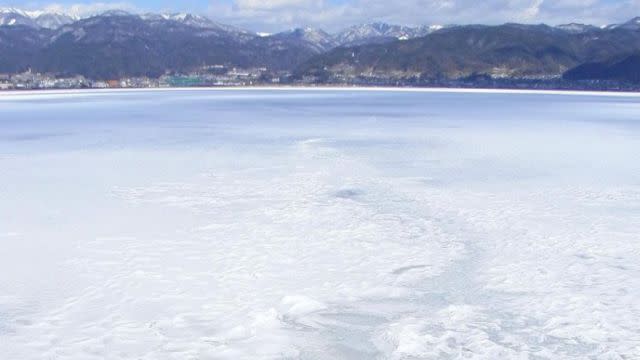For 600 years, Japanese monks have recorded climate data that scientists are using today

Each winter, Shinto monks living in the mountains of central Japan wait for ice ridges to appear on the frozen surface of Lake Suwa. The ridges, known as omiwatari, are believed to be the footsteps of a male Shinto god crossing the lake to visit a female god who resides on the other side, and their date of appearance is used to predict the weather that will be brought by the spring.

The Shinto monks have observed this tradition for the past six centuries and have recorded data about the ridges since 1443. Their records, which include the day on which the lake froze and how many days passed before the first ridges formed, are the oldest continuous record of climate data known to man.
Scientists today can use the freezing dates to gain insight into how winter weather has changed in the region. And since the data goes back well into the past, it gives a good picture of how human activity has affected Japan’s winters, too.
In 1954, German and Japanese scientists published a paper in which they broke up the data into two blocks, each two and half centuries long, representing the pre-Industrial and the post-Industrial periods. Their analysis showed that in the post-Industrial period, spanning from the 17th to the 20th century, Lake Suwa failed to freeze over twice as frequently as it did in the pre-Industrial period. Since the mid 17th century, they found, the lake remained unfrozen 27 times, compared to 13 times in the 250 years prior.
This week (April 26), American and Japanese scientists published a paper in Nature in which they analyzed the Japanese data alongside data on the freezing dates of the Torne River, which runs through Sweden and Finland.
“What is important about the two ice records analyzed in this paper is that they were recorded far into the past and included years before and after the start of the Industrial Revolution,” says John Magnuson, who led the study.
The Torne data goes back to the 17th century, when a merchant named Olof Ahlom started keeping records in 1693 of when the river began to melt. The river was important for trade, so local merchants continued to record the dates of ice break up each winter. The tradition continues today, with competitions in which people bet on when the date and time the ice will first begin to melt.
By looking at the two data sets side-by-side, the scientists found that both bodies of water were prone to freeze later, melt earlier, and have shorter ice-cover duration since the Industrial Revolution. While other methods for looking at the effect of the Industrial Revolution on the climate exist, such as paleo climatology or modeling studies, data recorded from direct observation is especially powerful at spreading awareness about climate change, according to Magnuson.
“I think that many people can relate to such apparently simple measures more than they can to more complex analyses,” he says.
Indeed, the warming climate’s effect on these bodies of water is shocking: Lake Suwa remained unfrozen twelve times in the 55-year period between 1950 and 2004, compared to only three times for a 255-year period from 1443 to 1700. And the Torne River experienced nine extreme warm years in the 14-year period between 2000 and 2013 and 10 extreme warm years in the 207-year period between 1693 and 1899.
Despite the increasing frequency of warm winters, the Shinto monks continue to observe tradition. In February 2012, they celebrated the first freezing of the lake since 2008.

Sign up for the Quartz Daily Brief, our free daily newsletter with the world’s most important and interesting news.
More stories from Quartz:

 Yahoo Finance
Yahoo Finance 